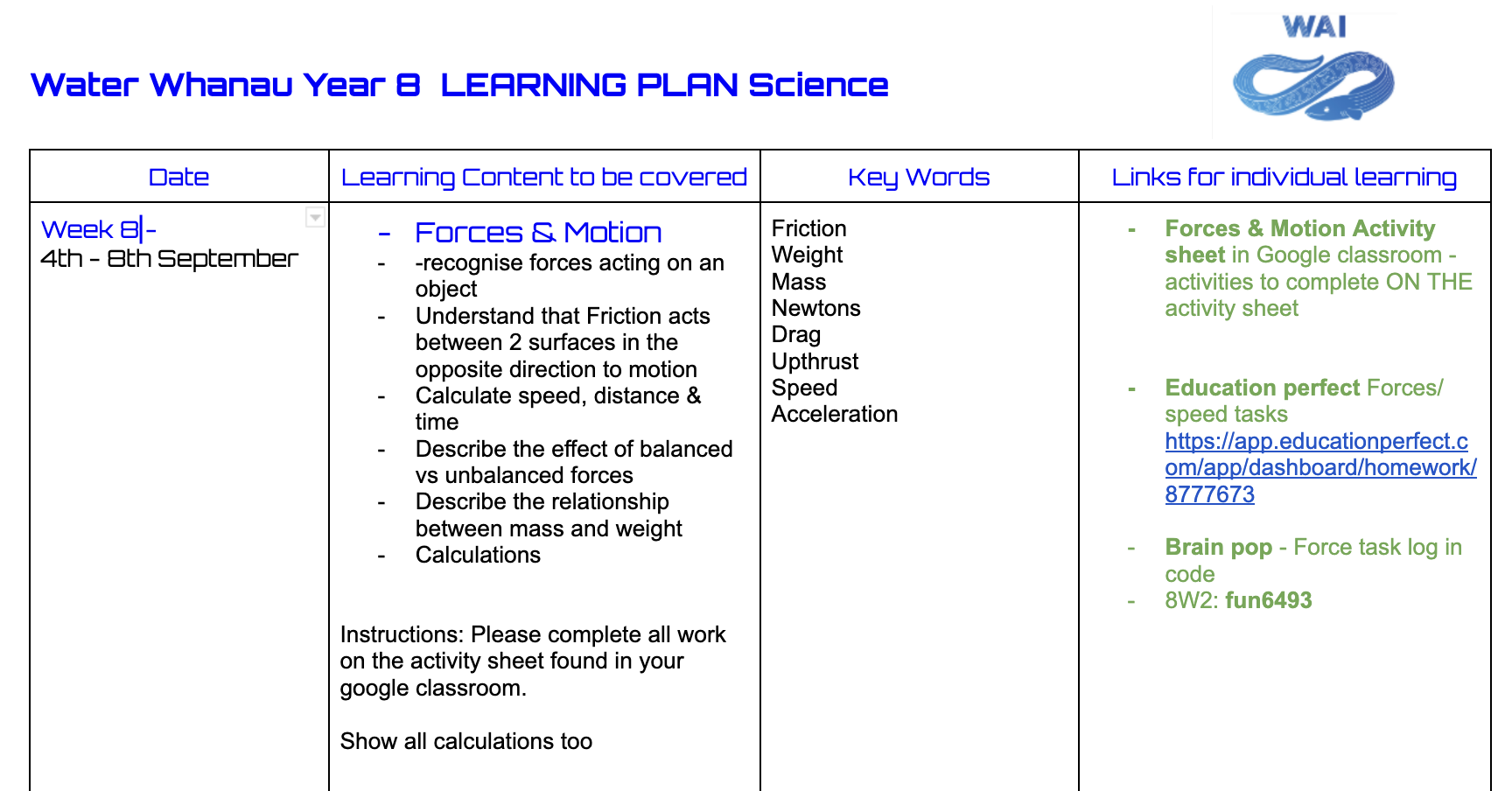8W2 Science
Section outline
-
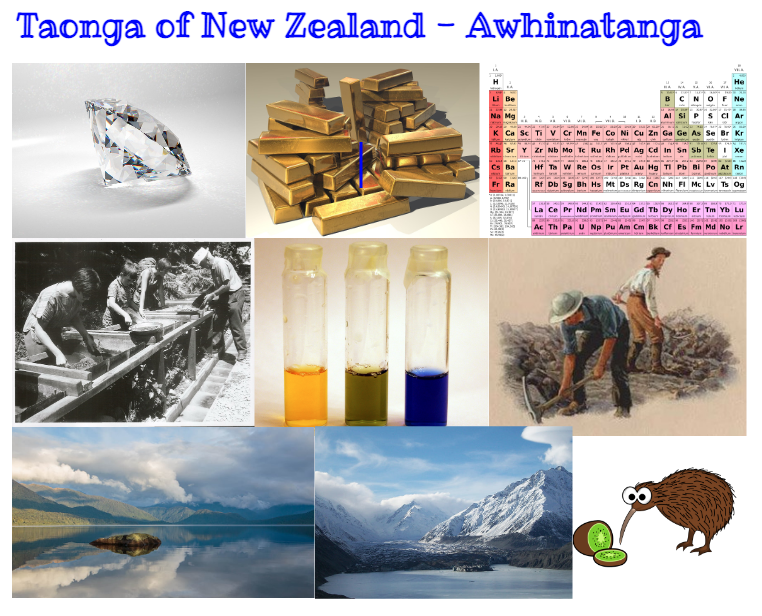 Learning Intentions
:
We are learning to (WALT)..
Learning Intentions
:
We are learning to (WALT)..- Explain the particle model of matter to someone
- Distinguish between physical and chemical reactions
- Describe the structure of the atom
- Describe the key differences between the 3 subatomic particles
- Describe the structure and function of the periodic table
- Use the periodic table to explain the structure of various different atoms
- Use the periodic table to draw an electron configuration diagram / orbital diagram
- Define the terms compound and mixture and be able to give examples of each
- Success Criteria: I can/have...
- Correctly explain the differences between solids, liquids and gasses using the particle model of matter
- Correctly tabulate the differences between physical and chemical reactions
- Accurately describe the structure of the atom
- Correctly identify and describe the key differences between the 3 subatomic particles
- Explain the structure and function of the periodic table
- Understand how to write word equations for chemical reactions
- Correctly describe the terms compound and mixture and be able to give examples of each
Activities:
- Google classroom tasks - Slideshows on the topic of the week
- Videos on the topic
- Education perfect tasks
Homework:
Work not completed in class will be for HOMEWORK. Please complete all your work in the google classroom doc - do NOT make a copy and store it else where !! Please also check your e-mails and google classroom for feedback on your work.
-
EXPLORE / TŪHURA learning intentions:
- We are EXPLORING the structure of the periodic table and how to interpret it
- We are EXPLORING the properties of mixtures, elements and compounds by researching and experimentation
- We are EXPLORING what different elements are made up of and how their characteristics determine how they are used
 Learning Intentions
:
We are learning to (WALT)..
Learning Intentions
:
We are learning to (WALT)..
- Explain the particle model of matter to someone
- Distinguish between physical and chemical reactions
- Describe the structure of the atom
- Describe the key differences between the 3 subatomic particles
- Describe the structure and function of the periodic table
- Use the periodic table to explain the structure of various different atoms
- Use the periodic table to draw an electron configuration diagram / orbital diagram
- Define the terms compound and mixture and be able to give examples of each
- Success Criteria: I can/have...
- Correctly explain the differences between solids, liquids and gasses using the particle model of matter
- Correctly tabulate the differences between physical and chemical reactions
- Accurately describe the structure of the atom
- Correctly identify and describe the key differences between the 3 subatomic particles
- Explain the structure and function of the periodic table
- Understand how to write word equations for chemical reactions
- Correctly describe the terms compound and mixture and be able to give examples of each
Activities:
- Google classroom tasks - Slideshows on the topic of the week
- Videos on the topic
- Education perfect tasks
Homework:
Work not completed in class will be for HOMEWORK. Please complete all your work in the google classroom doc - do NOT make a copy and store it else where !! Please also check your e-mails and google classroom for feedback on your work.
-
EXPLORE / TŪHURA learning intentions:
- We are EXPLORING the structure of the periodic table and how to interpret it
- We are EXPLORING the properties of mixtures, elements and compounds by researching and experimentation
- We are EXPLORING what different elements are made up of and how their characteristics determine how they are used
 Learning Intentions
:
We are learning to (WALT)..
Learning Intentions
:
We are learning to (WALT)..
- Explain the particle model of matter to someone
- Distinguish between physical and chemical reactions
- Describe the structure of the atom
- Describe the key differences between the 3 subatomic particles
- Describe the structure and function of the periodic table
- Use the periodic table to explain the structure of various different atoms
- Use the periodic table to draw an electron configuration diagram / orbital diagram
- Define the terms compound and mixture and be able to give examples of each
- Success Criteria: I can/have...
- Correctly explain the differences between solids, liquids and gasses using the particle model of matter
- Correctly tabulate the differences between physical and chemical reactions
- Accurately describe the structure of the atom
- Correctly identify and describe the key differences between the 3 subatomic particles
- Explain the structure and function of the periodic table
- Understand how to write word equations for chemical reactions
- Correctly describe the terms compound and mixture and be able to give examples of each
Activities:
- Google classroom tasks - Slideshows on the topic of the week
- Videos on the topic
- Education perfect tasks
Homework:
Work not completed in class will be for HOMEWORK. Please complete all your work in the google classroom doc - do NOT make a copy and store it else where !! Please also check your e-mails and google classroom for feedback on your work.
-
EXPLORE / TŪHURA learning intentions:
- We are EXPLORING the structure of the periodic table and how to interpret it
- We are EXPLORING the properties of mixtures, elements and compounds by researching and experimentation
- We are EXPLORING what different elements are made up of and how their characteristics determine how they are used
 Learning Intentions
:
We are learning to (WALT)..
Learning Intentions
:
We are learning to (WALT)..
- Explain the particle model of matter to someone
- Distinguish between physical and chemical reactions
- Describe the structure of the atom
- Describe the key differences between the 3 subatomic particles
- Describe the structure and function of the periodic table
- Use the periodic table to explain the structure of various different atoms
- Use the periodic table to draw an electron configuration diagram / orbital diagram
- Define the terms compound and mixture and be able to give examples of each
- Success Criteria: I can/have...
- Correctly explain the differences between solids, liquids and gasses using the particle model of matter
- Correctly tabulate the differences between physical and chemical reactions
- Accurately describe the structure of the atom
- Correctly identify and describe the key differences between the 3 subatomic particles
- Explain the structure and function of the periodic table
- Understand how to write word equations for chemical reactions
- Correctly describe the terms compound and mixture and be able to give examples of each
Activities:
- Google classroom tasks - Slideshows on the topic of the week
- Videos on the topic
- Education perfect tasks
Homework:
Work not completed in class will be for HOMEWORK. Please complete all your work in the google classroom doc - do NOT make a copy and store it else where !! Please also check your e-mails and google classroom for feedback on your work.
-
PLAN & DO / WHAKAMAHI learning intentions:
- We are PLANNING a number of practical investigations in class so that we can understand and explain why certain elements are considered valuable and what they are ultimately used for in the world
EXPLORE / TŪHURA learning intentions:
- We are EXPLORING the structure of the periodic table and how to interpret it
- We are EXPLORING the properties of mixtures, elements and compounds by researching and experimentation
- We are EXPLORING what different elements are made up of and how their characteristics determine how they are used
 Learning Intentions
:
We are learning to (WALT)..
Learning Intentions
:
We are learning to (WALT)..
- Explain the particle model of matter to someone
- Distinguish between physical and chemical reactions
- Describe the structure of the atom
- Describe the key differences between the 3 subatomic particles
- Describe the structure and function of the periodic table
- Use the periodic table to explain the structure of various different atoms
- Use the periodic table to draw an electron configuration diagram / orbital diagram
- Define the terms compound and mixture and be able to give examples of each
- Success Criteria: I can/have...
- Correctly explain the differences between solids, liquids and gasses using the particle model of matter
- Correctly tabulate the differences between physical and chemical reactions
- Accurately describe the structure of the atom
- Correctly identify and describe the key differences between the 3 subatomic particles
- Explain the structure and function of the periodic table
- Understand how to write word equations for chemical reactions
- Correctly describe the terms compound and mixture and be able to give examples of each
Activities:
- Google classroom tasks - Slideshows on the topic of the week
- Videos on the topic
- Education perfect tasks
Homework:
Work not completed in class will be for HOMEWORK. Please complete all your work in the google classroom doc - do NOT make a copy and store it else where !! Please also check your e-mails and google classroom for feedback on your work.
-
PLAN & DO / WHAKAMAHI learning intentions:
- We are PLANNING a number of practical investigations in class so that we can understand and explain why certain elements are considered valuable and what they are ultimately used for in the world
EXPLORE / TŪHURA learning intentions:
- We are EXPLORING the structure of the periodic table and how to interpret it
- We are EXPLORING the properties of mixtures, elements and compounds by researching and experimentation
- We are EXPLORING what different elements are made up of and how their characteristics determine how they are used
 Learning Intentions
:
We are learning to (WALT)..
Learning Intentions
:
We are learning to (WALT)..
- Explain the particle model of matter to someone
- Distinguish between physical and chemical reactions
- Describe the structure of the atom
- Describe the key differences between the 3 subatomic particles
- Describe the structure and function of the periodic table
- Use the periodic table to explain the structure of various different atoms
- Use the periodic table to draw an electron configuration diagram / orbital diagram
- Define the terms compound and mixture and be able to give examples of each
- Success Criteria: I can/have...
- Correctly explain the differences between solids, liquids and gasses using the particle model of matter
- Correctly tabulate the differences between physical and chemical reactions
- Accurately describe the structure of the atom
- Correctly identify and describe the key differences between the 3 subatomic particles
- Explain the structure and function of the periodic table
- Understand how to write word equations for chemical reactions
- Correctly describe the terms compound and mixture and be able to give examples of each
Activities:
- Google classroom tasks - Slideshows on the topic of the week
- Videos on the topic
- Education perfect tasks
Homework:
Work not completed in class will be for HOMEWORK. Please complete all your work in the google classroom doc - do NOT make a copy and store it else where !! Please also check your e-mails and google classroom for feedback on your work.
-
PLAN & DO / WHAKAMAHI learning intentions:
- We are PLANNING a number of practical investigations in class so that we can understand and explain why certain elements are considered valuable and what they are ultimately used for in the world
 Learning Intentions
:
We are learning to (WALT)..
Learning Intentions
:
We are learning to (WALT)..
- Explain the particle model of matter to someone
- Distinguish between physical and chemical reactions
- Describe the structure of the atom
- Describe the key differences between the 3 subatomic particles
- Describe the structure and function of the periodic table
- Use the periodic table to explain the structure of various different atoms
- Use the periodic table to draw an electron configuration diagram / orbital diagram
- Define the terms compound and mixture and be able to give examples of each
- Success Criteria: I can/have...
- Correctly explain the differences between solids, liquids and gasses using the particle model of matter
- Correctly tabulate the differences between physical and chemical reactions
- Accurately describe the structure of the atom
- Correctly identify and describe the key differences between the 3 subatomic particles
- Explain the structure and function of the periodic table
- Understand how to write word equations for chemical reactions
- Correctly describe the terms compound and mixture and be able to give examples of each
Activities:
- Google classroom tasks - Slideshows on the topic of the week
- Videos on the topic
- Education perfect tasks
Homework:
Work not completed in class will be for HOMEWORK. Please complete all your work in the google classroom doc - do NOT make a copy and store it else where !! Please also check your e-mails and google classroom for feedback on your work.
-
FOCUS / ARONGA learning intentions:
- We are FOCUSING on the Treasures of New Zealand and what we can do to preserve / advertise them to the world
 Learning Intentions
:
We are learning to (WALT)..
Learning Intentions
:
We are learning to (WALT)..
- Explain the particle model of matter to someone
- Distinguish between physical and chemical reactions
- Describe the structure of the atom
- Describe the key differences between the 3 subatomic particles
- Describe the structure and function of the periodic table
- Use the periodic table to explain the structure of various different atoms
- Use the periodic table to draw an electron configuration diagram / orbital diagram
- Define the terms compound and mixture and be able to give examples of each
- Success Criteria: I can/have...
- Correctly explain the differences between solids, liquids and gasses using the particle model of matter
- Correctly tabulate the differences between physical and chemical reactions
- Accurately describe the structure of the atom
- Correctly identify and describe the key differences between the 3 subatomic particles
- Explain the structure and function of the periodic table
- Understand how to write word equations for chemical reactions
- Correctly describe the terms compound and mixture and be able to give examples of each
Activities:
- Google classroom tasks - Slideshows on the topic of the week
- Videos on the topic
- Education perfect tasks
Homework:
Work not completed in class will be for HOMEWORK. Please complete all your work in the google classroom doc - do NOT make a copy and store it else where !! Please also check your e-mails and google classroom for feedback on your work.
-
FOCUS / ARONGA learning intentions:
- We are FOCUSING on the Treasures of New Zealand and what we can do to preserve / advertise them to the world
 Learning Intentions
:
We are learning to (WALT)..
Learning Intentions
:
We are learning to (WALT)..
- Explain the particle model of matter to someone
- Distinguish between physical and chemical reactions
- Describe the structure of the atom
- Describe the key differences between the 3 subatomic particles
- Describe the structure and function of the periodic table
- Use the periodic table to explain the structure of various different atoms
- Use the periodic table to draw an electron configuration diagram / orbital diagram
- Define the terms compound and mixture and be able to give examples of each
- Success Criteria: I can/have...
- Correctly explain the differences between solids, liquids and gasses using the particle model of matter
- Correctly tabulate the differences between physical and chemical reactions
- Accurately describe the structure of the atom
- Correctly identify and describe the key differences between the 3 subatomic particles
- Explain the structure and function of the periodic table
- Understand how to write word equations for chemical reactions
- Correctly describe the terms compound and mixture and be able to give examples of each
Activities:
- Google classroom tasks - Slideshows on the topic of the week
- Videos on the topic
- Education perfect tasks
Homework:
Work not completed in class will be for HOMEWORK. Please complete all your work in the google classroom doc - do NOT make a copy and store it else where !! Please also check your e-mails and google classroom for feedback on your work.
-
EXPLORE / TŪHURA learning intentions:
- We are EXPLORING Sound and the physical world by practically investigating its wave nature and how sound travels through a medium
- We are EXPLORING the biomechanics of music by building an instrument and explaining how this works
- We are EXPLORING the structure and function of the different parts of the ear, by researching and observing the external and internal structure of an ear.
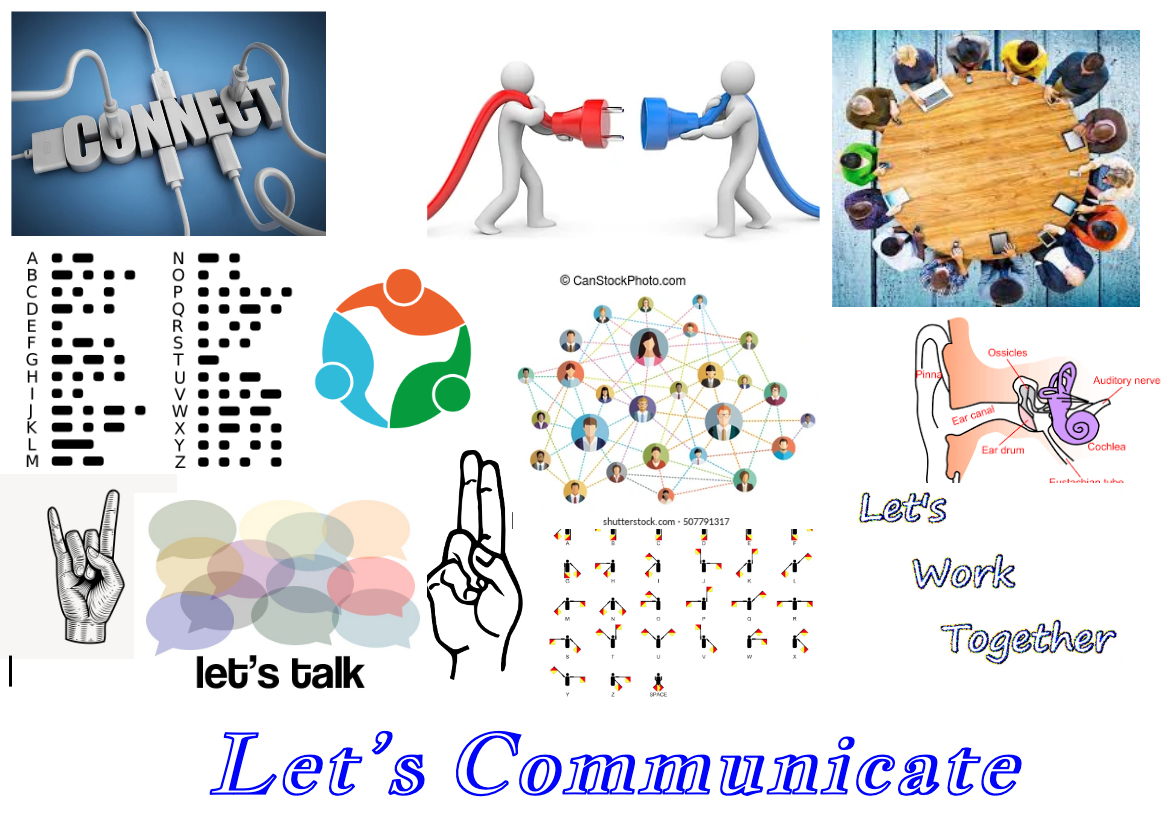
Learning Intentions : We are learning to (WALT)..
- Define the term energy
- Describe some common forms of energy
- Describe a number of energy transformations
- State "the law of Conservation of Energy"
- Define a wave and describe two common wave forms
- Identify the amplitude, frequency and wavelength of waves
- Dinie and describe sound waves in terms of pitch and loudness
- Describe the basic functioning of a human ear.
- Explain in detail how we hear
- Learn to communicate in sign language
- Success Criteria: I can/have...
- Discuss common forms of energy and explain how we use these forms in every day life
- Correctly define energy
- Correctly explain the differences between amplitude, frequency and wavelength
- Correctly tabulate the different forms of energy transformations between physical and chemical reactions
- Accurately define and describe sound waves in terms of pitch and loudness
- Understand how the human ear helps with hearing a sound
- Correctly communicate a sentence in sign language
Activities:
- Google classroom tasks - Slideshows on the topic of the week
- Videos on the topic
- Education perfect tasks
Homework:
Work not completed in class will be for HOMEWORK. Please complete all your work in the google classroom doc - do NOT make a copy and store it else where !! Please also check your e-mails and google classroom for feedback on your work.
-
EXPLORE / TŪHURA learning intentions:
- We are EXPLORING Sound and the physical world by practically investigating its wave nature and how sound travels through a medium
- We are EXPLORING the biomechanics of music by building an instrument and explaining how this works
- We are EXPLORING the structure and function of the different parts of the ear, by researching and observing the external and internal structure of an ear.

Learning Intentions : We are learning to (WALT)..
- Define the term energy
- Describe some common forms of energy
- Describe a number of energy transformations
- State "the law of Conservation of Energy"
- Define a wave and describe two common wave forms
- Identify the amplitude, frequency and wavelength of waves
- Dinie and describe sound waves in terms of pitch and loudness
- Describe the basic functioning of a human ear.
- Explain in detail how we hear
- Learn to communicate in sign language
- Success Criteria: I can/have...
- Discuss common forms of energy and explain how we use these forms in every day life
- Correctly define energy
- Correctly explain the differences between amplitude, frequency and wavelength
- Correctly tabulate the different forms of energy transformations between physical and chemical reactions
- Accurately define and describe sound waves in terms of pitch and loudness
- Understand how the human ear helps with hearing a sound
- Correctly communicate a sentence in sign language
Activities:
- Google classroom tasks - Slideshows on the topic of the week
- Videos on the topic
- Education perfect tasks
Homework:
Work not completed in class will be for HOMEWORK. Please complete all your work in the google classroom doc - do NOT make a copy and store it else where !! Please also check your e-mails and google classroom for feedback on your work.
-
EXPLORE / TŪHURA learning intentions:
- We are EXPLORING Sound and the physical world by practically investigating its wave nature and how sound travels through a medium
- We are EXPLORING the biomechanics of music by building an instrument and explaining how this works
- We are EXPLORING the structure and function of the different parts of the ear, by researching and observing the external and internal structure of an ear.

Learning Intentions : We are learning to (WALT)..
- Define the term energy
- Describe some common forms of energy
- Describe a number of energy transformations
- State "the law of Conservation of Energy"
- Define a wave and describe two common wave forms
- Identify the amplitude, frequency and wavelength of waves
- Dinie and describe sound waves in terms of pitch and loudness
- Describe the basic functioning of a human ear.
- Explain in detail how we hear
- Learn to communicate in sign language
- Success Criteria: I can/have...
- Discuss common forms of energy and explain how we use these forms in every day life
- Correctly define energy
- Correctly explain the differences between amplitude, frequency and wavelength
- Correctly tabulate the different forms of energy transformations between physical and chemical reactions
- Accurately define and describe sound waves in terms of pitch and loudness
- Understand how the human ear helps with hearing a sound
- Correctly communicate a sentence in sign language
Activities:
- Google classroom tasks - Slideshows on the topic of the week
- Videos on the topic
- Education perfect tasks
Homework:
Work not completed in class will be for HOMEWORK. Please complete all your work in the google classroom doc - do NOT make a copy and store it else where !! Please also check your e-mails and google classroom for feedback on your work.
-
EXPLORE / TŪHURA learning intentions:
- We are EXPLORING Sound and the physical world by practically investigating its wave nature and how sound travels through a medium
- We are EXPLORING the biomechanics of music by building an instrument and explaining how this works
- We are EXPLORING the structure and function of the different parts of the ear, by researching and observing the external and internal structure of an ear.

Learning Intentions : We are learning to (WALT)..
- Define the term energy
- Describe some common forms of energy
- Describe a number of energy transformations
- State "the law of Conservation of Energy"
- Define a wave and describe two common wave forms
- Identify the amplitude, frequency and wavelength of waves
- Dinie and describe sound waves in terms of pitch and loudness
- Describe the basic functioning of a human ear.
- Explain in detail how we hear
- Learn to communicate in sign language
- Success Criteria: I can/have...
- Discuss common forms of energy and explain how we use these forms in every day life
- Correctly define energy
- Correctly explain the differences between amplitude, frequency and wavelength
- Correctly tabulate the different forms of energy transformations between physical and chemical reactions
- Accurately define and describe sound waves in terms of pitch and loudness
- Understand how the human ear helps with hearing a sound
- Correctly communicate a sentence in sign language
Activities:
- Google classroom tasks - Slideshows on the topic of the week
- Videos on the topic
- Education perfect tasks
Homework:
Work not completed in class will be for HOMEWORK. Please complete all your work in the google classroom doc - do NOT make a copy and store it else where !! Please also check your e-mails and google classroom for feedback on your work.
-
EXPLORE / TŪHURA learning intentions:
- We are EXPLORING Sound and the physical world by practically investigating its wave nature and how sound travels through a medium
- We are EXPLORING the biomechanics of music by building an instrument and explaining how this works
- We are EXPLORING the structure and function of the different parts of the ear, by researching and observing the external and internal structure of an ear.

Learning Intentions : We are learning to (WALT)..
- Define the term energy
- Describe some common forms of energy
- Describe a number of energy transformations
- State "the law of Conservation of Energy"
- Define a wave and describe two common wave forms
- Identify the amplitude, frequency and wavelength of waves
- Dinie and describe sound waves in terms of pitch and loudness
- Describe the basic functioning of a human ear.
- Explain in detail how we hear
- Learn to communicate in sign language
- Success Criteria: I can/have...
- Discuss common forms of energy and explain how we use these forms in every day life
- Correctly define energy
- Correctly explain the differences between amplitude, frequency and wavelength
- Correctly tabulate the different forms of energy transformations between physical and chemical reactions
- Accurately define and describe sound waves in terms of pitch and loudness
- Understand how the human ear helps with hearing a sound
- Correctly communicate a sentence in sign language
Activities:
- Google classroom tasks - Slideshows on the topic of the week
- Videos on the topic
- Education perfect tasks
Homework:
Work not completed in class will be for HOMEWORK. Please complete all your work in the google classroom doc - do NOT make a copy and store it else where !! Please also check your e-mails and google classroom for feedback on your work.
-
EXPLORE / TŪHURA learning intentions:
- We are EXPLORING Sound and the physical world by practically investigating its wave nature and how sound travels through a medium
- We are EXPLORING the biomechanics of music by building an instrument and explaining how this works
- We are EXPLORING the structure and function of the different parts of the ear, by researching and observing the external and internal structure of an ear.

Learning Intentions : We are learning to (WALT)..
- Define the term energy
- Describe some common forms of energy
- Describe a number of energy transformations
- State "the law of Conservation of Energy"
- Define a wave and describe two common wave forms
- Identify the amplitude, frequency and wavelength of waves
- Identify and describe sound waves in terms of pitch and loudness
- Describe the basic functioning of a human ear.
- Explain in detail how we hear
- Learn to communicate in sign language
- Explore The transmission of sound and build a musical instrument
- Successfully explain how we can hear sound.
- Success Criteria: I can/have...
- Discuss common forms of energy and explain how we use these forms in every day life
- Correctly define energy
- Correctly explain the differences between amplitude, frequency and wavelength
- Correctly tabulate the different forms of energy transformations between physical and chemical reactions
- Accurately define and describe sound waves in terms of pitch and loudness
- Understand how the human ear helps with hearing a sound
- Correctly communicate a sentence in sign language
- Can explain how a musical instrument makes music
- Explain how we can hear musical notes
Activities:
- Google classroom tasks - Slideshows on the topic of the week
- Videos on the topic
- Education perfect tasks
Homework:
Work not completed in class will be for HOMEWORK. Please complete all your work in the google classroom doc - do NOT make a copy and store it else where !! Please also check your e-mails and google classroom for feedback on your work.
-
PLAN & DO / WHAKAMAHI learning intentions:
- We are PLANNING on practically investigating the nature of sound so that we can successfully build a musical instrument promote it to " bands " and demonstrate how it works

Learning Intentions : We are learning to (WALT)..
- Define the term energy
- Describe some common forms of energy
- Describe a number of energy transformations
- State "the law of Conservation of Energy"
- Define a wave and describe two common wave forms
- Identify the amplitude, frequency and wavelength of waves
- Identify and describe sound waves in terms of pitch and loudness
- Describe the basic functioning of a human ear.
- Explain in detail how we hear
- Learn to communicate in sign language
- Explore The transmission of sound and build a musical instrument
- Successfully explain how we can hear sound.
- Success Criteria: I can/have...
- Discuss common forms of energy and explain how we use these forms in every day life
- Correctly define energy
- Correctly explain the differences between amplitude, frequency and wavelength
- Correctly tabulate the different forms of energy transformations between physical and chemical reactions
- Accurately define and describe sound waves in terms of pitch and loudness
- Understand how the human ear helps with hearing a sound
- Correctly communicate a sentence in sign language
- Can explain how a musical instrument makes music
- Explain how we can hear musical notes
Activities:
- Google classroom tasks - Slideshows on the topic of the week
- Videos on the topic
- Education perfect tasks
Homework:
Work not completed in class will be for HOMEWORK. Please complete all your work in the google classroom doc - do NOT make a copy and store it else where !! Please also check your e-mails and google classroom for feedback on your work.
-
PLAN & DO / WHAKAMAHI learning intentions:
- We are PLANNING on practically investigating the nature of sound so that we can successfully build a musical instrument promote it to " bands " and demonstrate how it works

Learning Intentions : We are learning to (WALT)..
- Define the term energy
- Describe some common forms of energy
- Describe a number of energy transformations
- State "the law of Conservation of Energy"
- Define a wave and describe two common wave forms
- Identify the amplitude, frequency and wavelength of waves
- Identify and describe sound waves in terms of pitch and loudness
- Describe the basic functioning of a human ear.
- Explain in detail how we hear
- Learn to communicate in sign language
- Explore The transmission of sound and build a musical instrument
- Successfully explain how we can hear sound.
- Success Criteria: I can/have...
- Discuss common forms of energy and explain how we use these forms in every day life
- Correctly define energy
- Correctly explain the differences between amplitude, frequency and wavelength
- Correctly tabulate the different forms of energy transformations between physical and chemical reactions
- Accurately define and describe sound waves in terms of pitch and loudness
- Understand how the human ear helps with hearing a sound
- Correctly communicate a sentence in sign language
- Can explain how a musical instrument makes music
- Explain how we can hear musical notes
Activities:
- Google classroom tasks - Slideshows on the topic of the week
- Videos on the topic
- Education perfect tasks
Homework:
Work not completed in class will be for HOMEWORK. Please complete all your work in the google classroom doc - do NOT make a copy and store it else where !! Please also check your e-mails and google classroom for feedback on your work.
-
FOCUS / ARONGA learning intentions:
- We are FOCUSING on looking at different communication methods throughout the ages, and explaining how sound travels and how and why we are able to hear it.

Learning Intentions : We are learning to (WALT)..
- Define the term energy
- Describe some common forms of energy
- Describe a number of energy transformations
- State "the law of Conservation of Energy"
- Define a wave and describe two common wave forms
- Identify the amplitude, frequency and wavelength of waves
- Identify and describe sound waves in terms of pitch and loudness
- Describe the basic functioning of a human ear.
- Explain in detail how we hear
- Learn to communicate in sign language
- Explore The transmission of sound and build a musical instrument
- Successfully explain how we can hear sound.
- Success Criteria: I can/have...
- Discuss common forms of energy and explain how we use these forms in every day life
- Correctly define energy
- Correctly explain the differences between amplitude, frequency and wavelength
- Correctly tabulate the different forms of energy transformations between physical and chemical reactions
- Accurately define and describe sound waves in terms of pitch and loudness
- Understand how the human ear helps with hearing a sound
- Correctly communicate a sentence in sign language
- Can explain how a musical instrument makes music
- Explain how we can hear musical notes
Activities:
- Google classroom tasks - Slideshows on the topic of the week
- Videos on the topic
- Education perfect tasks
Homework:
Work not completed in class will be for HOMEWORK. Please complete all your work in the google classroom doc - do NOT make a copy and store it else where !! Please also check your e-mails and google classroom for feedback on your work.
-
FOCUS / ARONGA learning intentions:
- We are FOCUSING on looking at different communication methods throughout the ages, and explaining how sound travels and how and why we are able to hear it.

Learning Intentions : We are learning to (WALT)..
- Define the term energy
- Describe some common forms of energy
- Describe a number of energy transformations
- State "the law of Conservation of Energy"
- Define a wave and describe two common wave forms
- Identify the amplitude, frequency and wavelength of waves
- Identify and describe sound waves in terms of pitch and loudness
- Describe the basic functioning of a human ear.
- Explain in detail how we hear
- Learn to communicate in sign language
- Explore The transmission of sound and build a musical instrument
- Successfully explain how we can hear sound.
- Success Criteria: I can/have...
- Discuss common forms of energy and explain how we use these forms in every day life
- Correctly define energy
- Correctly explain the differences between amplitude, frequency and wavelength
- Correctly tabulate the different forms of energy transformations between physical and chemical reactions
- Accurately define and describe sound waves in terms of pitch and loudness
- Understand how the human ear helps with hearing a sound
- Correctly communicate a sentence in sign language
- Can explain how a musical instrument makes music
- Explain how we can hear musical notes
Activities:
- Google classroom tasks - Slideshows on the topic of the week
- Videos on the topic
- Education perfect tasks
Homework:
Work not completed in class will be for HOMEWORK. Please complete all your work in the google classroom doc - do NOT make a copy and store it else where !! Please also check your e-mails and google classroom for feedback on your work.
-
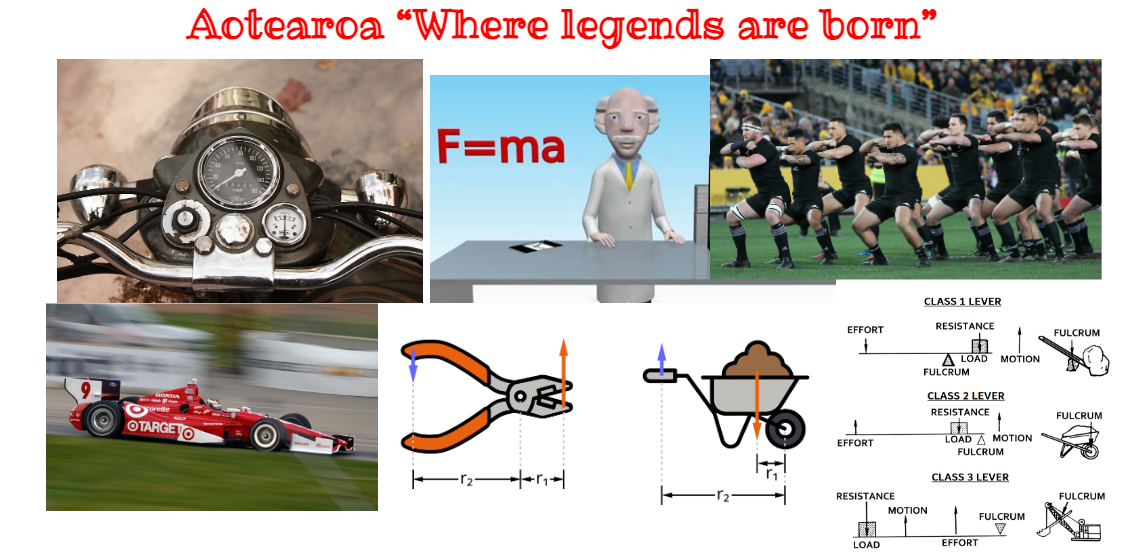
Learning Intentions : We are learning to (WALT)..
- Define the term force
- Describe the effects of a force
- Describe how balanced and unbalanced forces affect the movement of objects
- Investigate levers and simple machines
- Calculate forces
- Understand the difference between mass and weight
- Investigate factors that affect speed
- Calculate speed of objects
- Success Criteria: I can/have...
- Discuss different forces and their effects
- Describe how balanced and unbalanced forces affect the movement of objects
- Build a simple machine - mouse trap
- Successfully perform simple Force, mass, weight and speed calculations
Activities:
- Google classroom tasks - Slideshows on the topic of the week
- Videos on the topic
- Education perfect tasks
- Build a simple machine
Homework:
Work not completed in class will be for HOMEWORK. Please complete all your work in the google classroom doc - do NOT make a copy and store it else where !! Please also check your e-mails and google classroom for feedback on your work.
-

Learning Intentions : We are learning to (WALT)..
- Define the term force
- Describe the effects of a force
- Describe how balanced and unbalanced forces affect the movement of objects
- Investigate levers and simple machines
- Calculate forces
- Understand the difference between mass and weight
- Investigate factors that affect speed
- Calculate speed of objects
- Success Criteria: I can/have...
- Discuss different forces and their effects
- Describe how balanced and unbalanced forces affect the movement of objects
- Build a simple machine - mouse trap
- Successfully perform simple Force, mass, weight and speed calculations
Activities:
- Google classroom tasks - Slideshows on the topic of the week
- Videos on the topic
- Education perfect tasks
- Build a simple machine
Homework:
Work not completed in class will be for HOMEWORK. Please complete all your work in the google classroom doc - do NOT make a copy and store it else where !! Please also check your e-mails and google classroom for feedback on your work.
-

Learning Intentions : We are learning to (WALT)..
- Define the term force
- Describe the effects of a force
- Describe how balanced and unbalanced forces affect the movement of objects
- Investigate levers and simple machines
- Calculate forces
- Understand the difference between mass and weight
- Investigate factors that affect speed
- Calculate speed of objects
- Success Criteria: I can/have...
- Discuss different forces and their effects
- Describe how balanced and unbalanced forces affect the movement of objects
- Build a simple machine - mouse trap
- Successfully perform simple Force, mass, weight and speed calculations
Activities:
- Google classroom tasks - Slideshows on the topic of the week
- Videos on the topic
- Education perfect tasks
- Build a simple machine
Homework:
Work not completed in class will be for HOMEWORK. Please complete all your work in the google classroom doc - do NOT make a copy and store it else where !! Please also check your e-mails and google classroom for feedback on your work.
-

Learning Intentions : We are learning to (WALT)..
- Define the term force
- Describe the effects of a force
- Describe how balanced and unbalanced forces affect the movement of objects
- Investigate levers and simple machines
- Calculate forces
- Understand the difference between mass and weight
- Investigate factors that affect speed
- Calculate speed of objects
- Success Criteria: I can/have...
- Discuss different forces and their effects
- Describe how balanced and unbalanced forces affect the movement of objects
- Build a simple machine - mouse trap
- Successfully perform simple Force, mass, weight and speed calculations
Activities:
- Google classroom tasks - Slideshows on the topic of the week
- Videos on the topic
- Education perfect tasks
- Build a simple machine
Homework:
Work not completed in class will be for HOMEWORK. Please complete all your work in the google classroom doc - do NOT make a copy and store it else where !! Please also check your e-mails and google classroom for feedback on your work.
-

Learning Intentions : We are learning to (WALT)..
- Define the term force
- Describe the effects of a force
- Describe how balanced and unbalanced forces affect the movement of objects
- Investigate levers and simple machines
- Calculate forces
- Understand the difference between mass and weight
- Investigate factors that affect speed
- Calculate speed of objects
- Success Criteria: I can/have...
- Discuss different forces and their effects
- Describe how balanced and unbalanced forces affect the movement of objects
- Build a simple machine - mouse trap
- Successfully perform simple Force, mass, weight and speed calculations
Activities:
- Google classroom tasks - Slideshows on the topic of the week
- Videos on the topic
- Education perfect tasks
- Build a simple machine
Homework:
Work not completed in class will be for HOMEWORK. Please complete all your work in the google classroom doc - do NOT make a copy and store it else where !! Please also check your e-mails and google classroom for feedback on your work.
-
EXPLORE / TŪHURA learning intentions:
- We are EXPLORING unique legends of NZ by observing and researching and at the NZ Natural World and its organisms
- We are EXPLORING the Material world strand, by looking at NZ scientists that played a role in atomic science
- We are EXPLORING The Physical World Strand by investigating legend sport stars and the physics behind the different sports
MHJC Great Learner Learning to Learn / Ako: Learning and Thinking Strategy
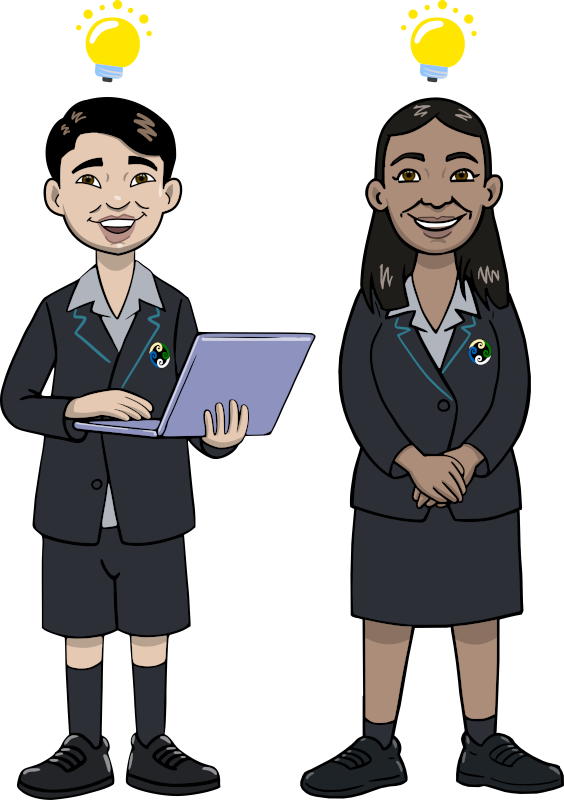

Learning Intentions : We are learning to (WALT)..
- Define the term force
- Describe the effects of a force
- Describe how balanced and unbalanced forces affect the movement of objects
- Investigate levers and simple machines
- Calculate forces
- Understand the difference between mass and weight
- Investigate factors that affect speed
- Calculate speed of objects
- Investigate the correct way to write up a scientific investigation
- Actually practise writing up Conclusions and Discussions in preparation for assessment 2
- Success Criteria: I can/have...
- Discuss different forces and their effects
- Describe how balanced and unbalanced forces affect the movement of objects
- Build a simple machine - mouse trap
- Successfully perform simple Force, mass, weight and speed calculations
- Successfully identify the different steps for writing up scientific investigations
Activities:
- Google classroom tasks - Slideshows on the topic of the week
- Videos on the topic
- Education perfect tasks
- Build a simple machine
Homework:
Work not completed in class will be for HOMEWORK. Please complete all your work in the google classroom doc - do NOT make a copy and store it else where !! Please also check your e-mails and google classroom for feedback on your work.
-
EXPLORE / TŪHURA learning intentions:
- We are EXPLORING unique legends of NZ by observing and researching and at the NZ Natural World and its organisms
- We are EXPLORING the Material world strand, by looking at NZ scientists that played a role in atomic science
- We are EXPLORING The Physical World Strand by investigating legend sport stars and the physics behind the different sports
MHJC Great Learner Learning to Learn / Ako: Learning and Thinking Strategy


Learning Intentions : We are learning to (WALT)..
- Define the term force
- Describe the effects of a force
- Describe how balanced and unbalanced forces affect the movement of objects
- Investigate levers and simple machines
- Calculate forces
- Understand the difference between mass and weight
- Investigate factors that affect speed
- Calculate speed of objects
- Investigate the correct way to write up a scientific investigation
- Actually practise writing up Conclusions and Discussions in preparation for assessment 2
- Carry out a practical investigation involving forces/ friction and air resistance as part of their assessment 2
- Success Criteria: I can/have...
- Discuss different forces and their effects
- Describe how balanced and unbalanced forces affect the movement of objects
- Build a simple machine - mouse trap
- Successfully perform simple Force, mass, weight and speed calculations
- Successfully identify the different steps for writing up scientific investigations
- Successfully write up the report from an investigation completed in class
Activities:
- Google classroom tasks - Slideshows on the topic of the week
- Videos on the topic
- Education perfect tasks
- Build a simple machine
Homework:
Work not completed in class will be for HOMEWORK. Please complete all your work in the google classroom doc - do NOT make a copy and store it else where !! Please also check your e-mails and google classroom for feedback on your work.
-
PLAN & DO / WHAKAMAHI learning intentions:
- We are PLANNING on investigating the Motor sport NZ Legends - so that we can fully investigate the physical world and the forces involved with these legends sport
FOCUS / ARONGA learning intentions:
- We are FOCUSING on the identifying how key legends have contributed to our knowledge of the world
FOCUS / ARONGA learning intentions:
- We are FOCUSING on the Treasures of New Zealand and what we can do to preserve / advertise them to the world
-
PLAN & DO / WHAKAMAHI learning intentions:
- We are PLANNING on investigating the Motor sport NZ Legends - so that we can fully investigate the physical world and the forces involved with these legends sport
FOCUS / ARONGA learning intentions:
- We are FOCUSING on the identifying how key legends have contributed to our knowledge of the world
-
Learning Intentions : We are learning to (WALT)..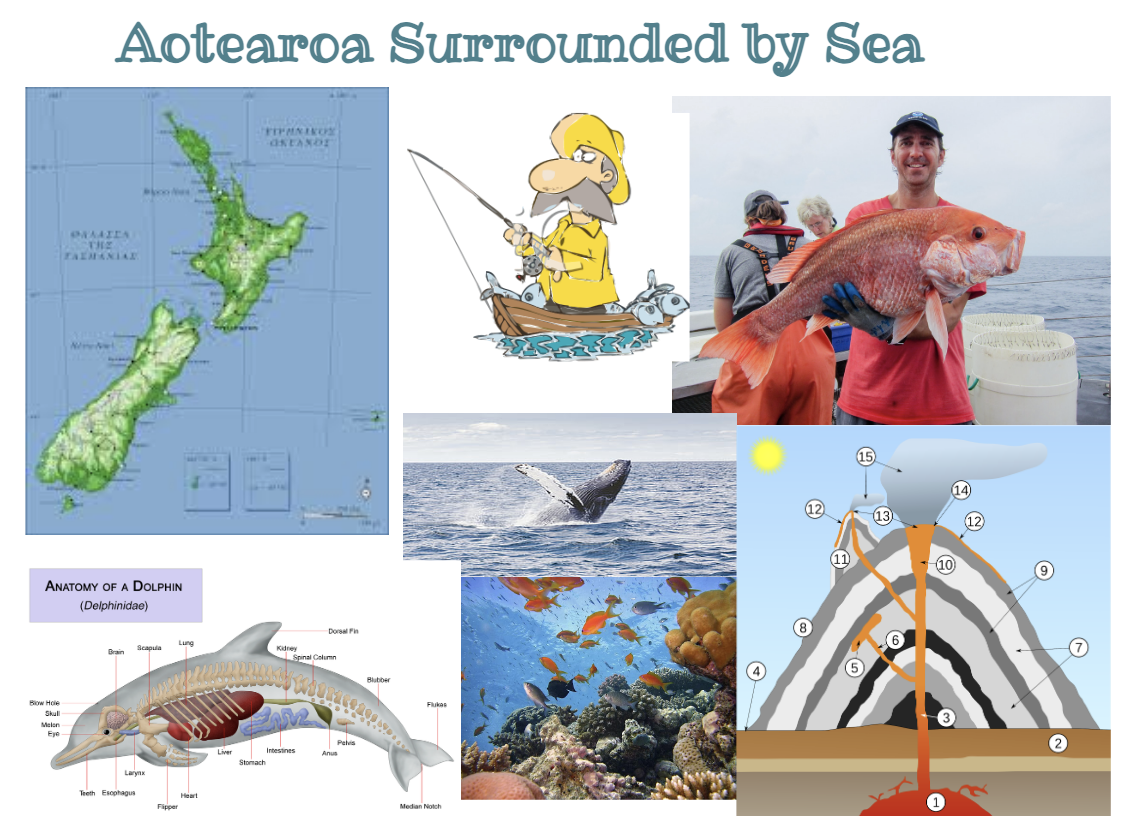
- Distinguish between ecosystems, communities and populations
- Define the term habitat and describe the habitats of a range of organisms
- Describe how an organism's adaptations help it to survive in its habitat
- Describe the relationship between predators and their prey.
- Construct food chains to show feeding interactions within a community
- Use food chains to construct food webs
- Use ecological pyramids to describe producer and consumer relationships
- Success Criteria: I can/have...
- Successfully explain the different ecological terms
- Describe how and organism is adapted to their environment
- Build a simple food chain and food web
- Explain in detail the producer consumer relationships
Activities:
- Google classroom tasks - Slideshows on the topic of the week
- Videos on the topic
- Education perfect tasks
Work not completed in class will be for HOMEWORK. Please complete all your work in the google classroom doc - do NOT make a copy and store it else where !! Please also check your e-mails and google classroom for feedback on your work.
-
Learning Intentions : We are learning to (WALT)..
- Distinguish between ecosystems, communities and populations
- Define the term habitat and describe the habitats of a range of organisms
- Describe how an organism's adaptations help it to survive in its habitat
- Describe the relationship between predators and their prey.
- Construct food chains to show feeding interactions within a community
- Use food chains to construct food webs
- Use ecological pyramids to describe producer and consumer relationships
- Success Criteria: I can/have...
- Successfully explain the different ecological terms
- Describe how and organism is adapted to their environment
- Build a simple food chain and food web
- Explain in detail the producer consumer relationships
Activities:
- Google classroom tasks - Slideshows on the topic of the week
- Videos on the topic
- Education perfect tasks
Homework:
Work not completed in class will be for HOMEWORK. Please complete all your work in the google classroom doc - do NOT make a copy and store it else where !! Please also check your e-mails and google classroom for feedback on your work.
-
Learning Intentions : We are learning to (WALT)..
- Distinguish between ecosystems, communities and populations
- Define the term habitat and describe the habitats of a range of organisms
- Describe how an organism's adaptations help it to survive in its habitat
- Describe the relationship between predators and their prey.
- Construct food chains to show feeding interactions within a community
- Use food chains to construct food webs
- Use ecological pyramids to describe producer and consumer relationships
- Success Criteria: I can/have...
- Successfully explain the different ecological terms
- Describe how and organism is adapted to their environment
- Build a simple food chain and food web
- Explain in detail the producer consumer relationships
Activities:
- Google classroom tasks - Slideshows on the topic of the week
- Videos on the topic
- Education perfect tasks
- Build a simple machine
Homework:
Work not completed in class will be for HOMEWORK. Please complete all your work in the google classroom doc - do NOT make a copy and store it else where !! Please also check your e-mails and google classroom for feedback on your work.



